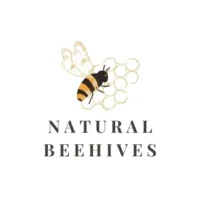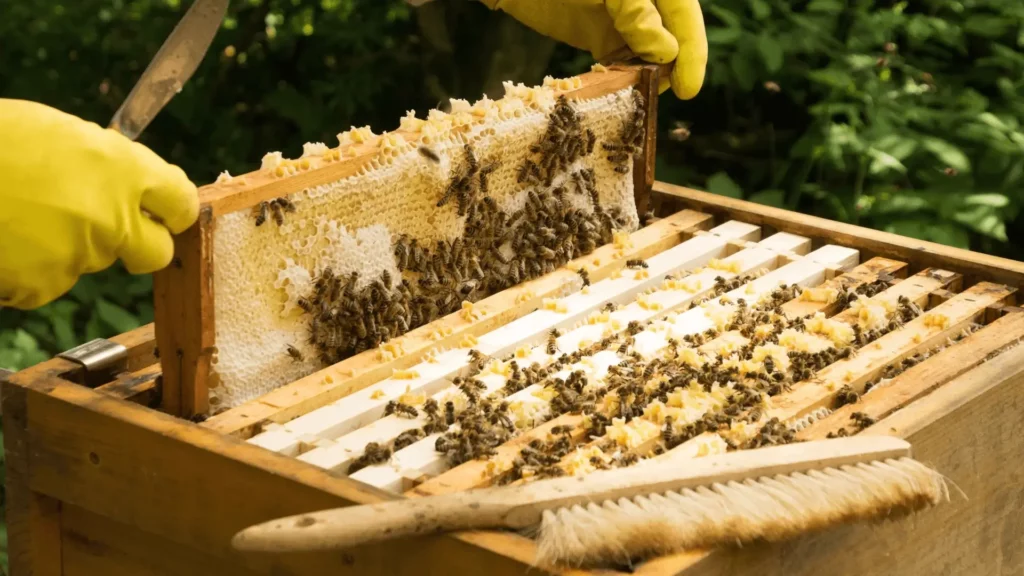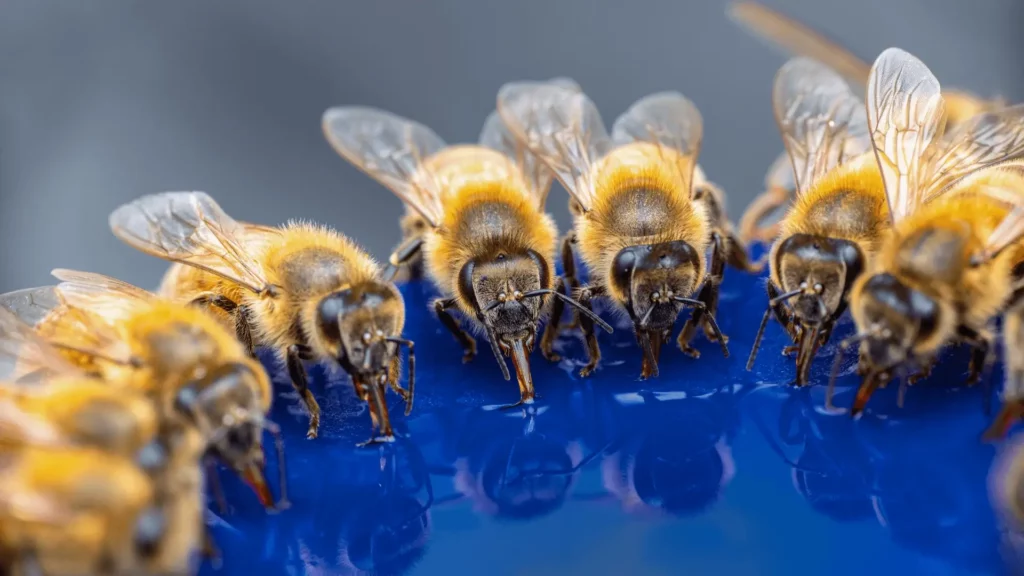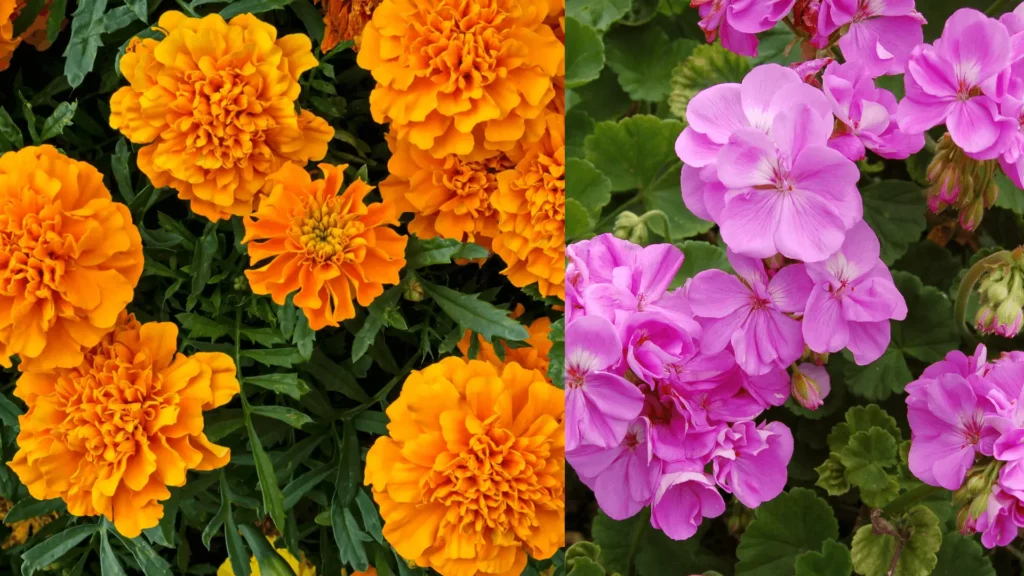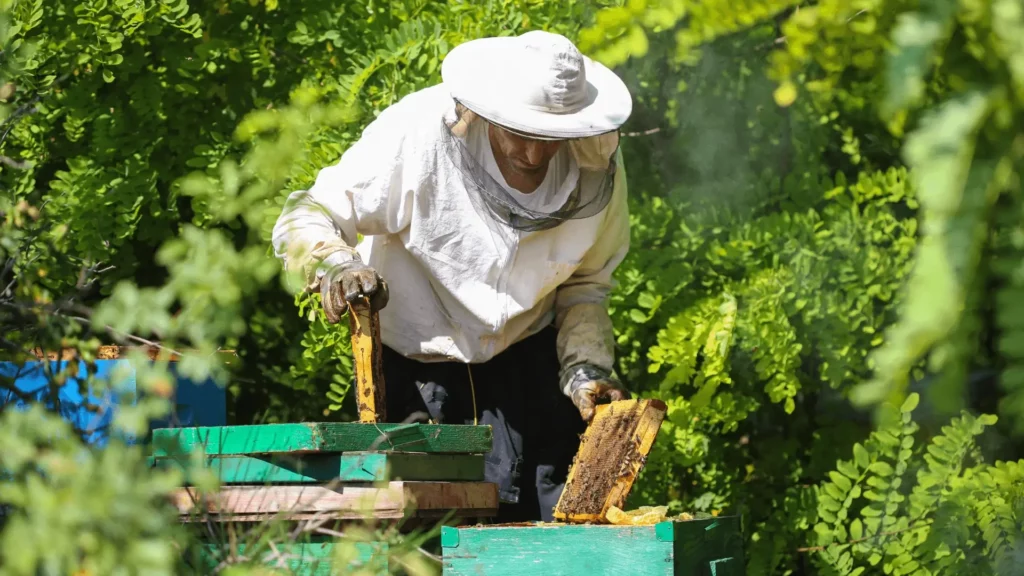
Are you ready to take your beekeeping practices to the next level? Imagine a world where your bees thrive, your honey is pure, and your impact on the environment is minimal. This is the world of sustainable beekeeping, where natural practices reign supreme.
In this article, we will dive into the fascinating realm of sustainable beekeeping and explore the myriad benefits it offers. From promoting bee health to increasing honey production, natural beekeeping methods have proven to be a game-changer for both the bees and the beekeepers.
Throughout this article, we will discuss the importance of embracing natural practices in beekeeping and the positive impact it has on the ecosystem. We’ll explore the various methods and techniques involved in sustainable beekeeping, providing valuable insights for those looking to make the switch or start afresh.
If you’re a beekeeper who wants to prioritize the well-being of your bees while enjoying the sweet rewards of sustainable honey production, this article is for you.
Introduction to Natural Beekeeping
Natural beekeeping is a sustainable approach to beekeeping that prioritizes the well-being of both bees and the environment. This method involves working with the natural instincts and behaviors of bees, rather than manipulating them for increased honey production. By embracing natural practices, beekeepers can create a harmonious relationship with their colonies while also contributing to the preservation of bee populations and the overall health of the ecosystem.
Key Principles:
1. Minimal intervention: Natural beekeeping focuses on minimizing human interference in the hive, allowing bees to build comb and manage their own colonies.
2. Chemical-free: Unlike conventional beekeeping, natural beekeeping avoids the use of synthetic chemicals or pesticides, ensuring a healthier environment for both bees and other wildlife.
3. Genetic diversity: Natural beekeepers prioritize maintaining diverse bee populations, which helps strengthen their resilience against pests and diseases.
4. Hive design: Natural beehives, such as top-bar hives and Warré hives, provide bees with a more natural living environment, allowing for the expression of their natural behaviors.
By adopting natural beekeeping practices, beekeepers can contribute to the conservation of bees and other pollinators, promote ecosystem biodiversity, and enjoy the satisfaction of working in harmony with nature.
Why is Natural Beekeeping Important?
Natural beekeeping is not just a trend; it is a vital practice for the well-being of both bees and the environment. By embracing natural beekeeping methods, beekeepers can make a positive impact on the ecosystem and honey production. Here are the reasons why natural beekeeping is important:
Environmental Sustainability
Natural beekeeping prioritizes environmental sustainability by avoiding the use of harmful chemicals and pesticides. This helps to protect the delicate balance of the ecosystem and promotes biodiversity. Bees, as pollinators, play a significant role in maintaining the diversity of plant and animal species. By practicing natural beekeeping, beekeepers contribute to the preservation and regeneration of natural habitats.
Preserving Genetic Diversity
Intensive beekeeping practices often involve breeding specific bee strains for high honey production, which can lead to a loss of genetic diversity. In contrast, natural beekeeping encourages the preservation of diverse and resilient bee populations. By supporting genetic diversity, beekeepers help strengthen bee colonies’ ability to withstand environmental challenges, diseases, and climate change.
Holistic Hive Management
Natural beekeeping focuses on holistic hive management, which entails considering the overall well-being of bee colonies. Instead of prioritizing honey production above all else, natural beekeepers take into account factors like colony health, stress reduction, and natural behaviors. This approach minimizes the negative impact of stressors and ensures the long-term vitality of the bees.
Background of Natural Beekeeping
Natural beekeeping, also known as organic or holistic beekeeping, is an approach to beekeeping that focuses on the well-being and preservation of bee colonies while minimizing human intervention. It emphasizes sustainable practices and the use of natural materials, without the reliance on synthetic chemicals or artificial treatments.
The origins of natural beekeeping can be traced back to early civilizations that relied on the natural behavior of bees for honey and beeswax. However, the modern concept of natural beekeeping began to gain prominence in the 20th century as a response to the negative effects of intensive beekeeping practices.
During the mid-20th century, the rise of industrial agriculture brought about the widespread use of pesticides and chemicals in beekeeping. Concerns grew about the impact of these substances on bee health and the environment. As a result, beekeepers started to explore alternative methods that focused on promoting the natural tendencies and resilience of bees.
Authors such as Rudolf Steiner and his development of biodynamic agriculture, as well as beekeepers like Émile Warré and his emphasis on natural hive designs, greatly influenced the growth of natural beekeeping. These pioneers recognized the importance of mimicking the natural habitats and behaviors of bees to support their overall health and vitality.
Today, natural beekeeping techniques continue to evolve, incorporating elements of permaculture, regenerative agriculture, and sustainable land management. By embracing natural practices, beekeepers aim to create a harmonious relationship between bees, their environment, and human interactions.
Environmental Benefits of Natural Beekeeping Practices
In the realm of beekeeping, embracing natural practices holds tremendous benefits for the environment. Natural beekeeping promotes biodiversity and plays a vital role in preserving ecological balance. By avoiding the use of harmful chemicals and pesticides, natural beekeeping minimizes pollution and safeguards the health of the surrounding ecosystem.
One of the significant advantages of natural beekeeping is its positive impact on biodiversity. Bees play a crucial role in pollinating a wide range of plants, contributing to the reproduction and growth of various species. By adopting natural beekeeping methods, beekeepers create habitats that support diverse plant life, ensuring a rich and thriving ecosystem.
Furthermore, practicing natural beekeeping helps minimize chemical pollution. Unlike conventional beekeeping methods that involve the use of synthetic pesticides and herbicides, natural beekeeping prioritizes the well-being of both bees and the environment. By steering clear of harmful substances, natural beekeepers prevent the contamination of soil, water, and air, ensuring a healthier environment for all living beings.
Embracing natural beekeeping practices is not only beneficial for bee health but also for the sustained well-being of the environment. By promoting biodiversity and avoiding chemical pollution, natural beekeepers contribute to the conservation of ecosystems and create a harmonious balance in nature.
Preserving Genetic Diversity in Bee Populations
Natural beekeeping practices play a crucial role in the preservation of diverse and resilient bee populations. By prioritizing sustainable and environmentally friendly approaches, natural beekeepers help maintain the genetic diversity essential for the long-term health and adaptation of bee colonies.
One of the major concerns in conventional beekeeping is the overreliance on imported and uniform honey bee strains. These strains may lack the genetic diversity necessary to withstand various environmental pressures, pests, and diseases. In contrast, natural beekeeping emphasizes the use of locally adapted bee stocks, allowing for a diverse mix of genetic traits that can enhance colony health and survival.
Furthermore, natural beekeepers prioritize colony selection and breeding methods that promote natural resistance to common bee diseases and pests. Instead of relying heavily on chemical treatments, they focus on fostering bees that are better equipped to handle challenges through innate adaptive traits.
This proactive approach not only contributes to the resilience of bee populations but also helps to reduce the reliance on chemicals and promotes more sustainable management practices. By embracing natural beekeeping methods, beekeepers can actively contribute to the preservation of diverse, healthy, and thriving honey bee populations.
Natural Beekeeping Management for Optimal Colony Health
Natural beekeeping methods prioritize the health and well-being of bee colonies, aiming to minimize stress and support their overall vitality. By adopting holistic practices, beekeepers can create an environment that promotes optimum colony performance. Let’s explore some key aspects of natural beekeeping management:
1. Hive Location and Design
One important element of natural beekeeping is selecting an appropriate location for the beehives. Placing hives in areas with abundant nectar and pollen sources ensures a diverse diet for the bees, resulting in stronger colonies. Moreover, the design of the hive itself plays a crucial role. Natural beekeepers often opt for hive styles such as top-bar hives or Warré hives, which provide bees with the freedom to build their comb in a manner that suits their natural behavior.
2. Minimal Intervention Approach
Unlike intensive beekeeping methods that involve frequent hive inspections and interventions, natural beekeeping adopts a more hands-off approach. Beekeepers minimize disturbance to the colonies, avoiding unnecessary intrusions that disrupt the bees’ natural rhythm. This approach helps reduce stress on the bees and allows them to regulate their population, build strong immunity, and engage in natural behaviors like swarming.
3. Organic and Natural Treatments
Natural beekeepers prioritize using organic and natural treatments for common bee health issues, such as mite infestations or diseases. They avoid the use of synthetic chemicals or antibiotics that can negatively impact bee and hive health. Instead, they focus on preventive measures, regular monitoring, and employing natural remedies when necessary.
4. Sustainable Beekeeping Practices
Natural beekeeping aligns with sustainable practices, emphasizing responsible hive management techniques. This includes promoting genetic diversity within bee colonies, encouraging their natural growth and reproduction, and supporting the overall resilience of the ecosystem. By allowing bees to thrive in their natural state, natural beekeepers contribute to the conservation of pollinators and the preservation of healthy ecosystems.
Also read: Discover the Benefits of Beekeeping
Optimal Beehive Choices for Natural Beekeeping
When practicing natural beekeeping, choosing the right beehive is essential for the well-being of the colony and the success of the endeavor. Unlike intensive beekeeping methods that often rely on standardized frame hives, natural beekeeping embraces alternative hive designs that prioritize the bees’ natural behavior and needs. Here are two popular types of beehives that are commonly used in natural beekeeping:
Top-Bar Hives
Top-bar hives are horizontal hives that provide a more organic habitat for bees. Instead of using frames, top-bar hives feature a long, wooden bar placed horizontally across the hive. Bees build their own combs, suspended from the top bars, giving them the freedom to construct their hive according to their instincts. This design allows for better ventilation, as bees can incorporate more airflow into the hive. It also provides a more natural brood pattern and reduces the risk of diseases caused by crowded frames.
Warré Hives
Warré hives, also known as the “People’s Hive,” were designed with the philosophy of mimicking the natural habitat of bees in mind. These vertical hives consist of several boxes stacked on top of each other, with each box acting as a separate living space for the colony. Bees build their comb downward, following their natural inclination. This design allows for less intrusive management and promotes better thermoregulation within the hive. Warré hives are often favored by natural beekeepers due to their low-intervention approach and focus on colony health.
Both top-bar hives and Warré hives offer advantages for natural beekeeping, such as providing a more bee-centric environment, better honey production, and reduced stress on the bees. However, it’s important to note that each hive type has its own management techniques, and beekeepers should familiarize themselves with the specific requirements of their chosen hive.
By opting for alternative hive designs in natural beekeeping, beekeepers can better support the bees’ natural behavior and overall well-being, fostering a more sustainable and harmonious approach to beekeeping.
Also read: Exploring Bee Habitats: Where Do Bees Live and How to Support Them
Intensive Beekeeping in Frame Hives
Intensive beekeeping, a widely practiced method that utilizes traditional frame hives, has long been a popular approach for honey production. In this system, the bees’ activities are closely managed and controlled to maximize productivity. Here’s an overview of intensive beekeeping in frame hives and its key characteristics.
Hive Structure and Organization
The foundation of intensive beekeeping lies in the use of frame hives, which consist of wooden boxes with removable frames that hold beeswax foundation sheets. These frames provide a convenient setup for beekeepers to inspect, manipulate, and manage their colonies. The standardized size of the frames allows for easy transport and exchange of bees and brood among hives.
Queen Management and Bee Population
In intensive beekeeping, queen performance plays a crucial role in honey production. Beekeepers closely monitor the queen’s egg-laying activity and overall health. They may practice queen breeding and replacement techniques to ensure a high population of bees during the peak nectar flow, resulting in increased honey yields.
Honey Extraction
Intensive beekeepers often use centrifugal methods to extract honey from the frames. After removing the frames from the hive, the honeycombs are uncapped, and the frames are placed in a centrifuge to remove the honey. This process allows for efficient extraction while keeping the frames intact for future use.
Management Practices
Intensive beekeeping involves regular interventions by beekeepers to control common issues such as pests, diseases, and swarming. Varroa mite treatments, medication for disease prevention, and honey supplementation during low nectar flows are some commonly employed practices. These interventions aim to maintain colony health and optimize honey production throughout the year.
While intensive beekeeping has its advantages in terms of honey yields and management control, it is important to consider the potential downsides. The intensive manipulation of colonies and the use of chemicals for pest control may pose challenges in terms of honey quality, negative environmental impact, and potential stress on bee health.
As beekeepers explore different approaches to honey production, it is essential to weigh the benefits and drawbacks of intensive beekeeping in frame hives and consider alternative methods, such as natural beekeeping, that prioritize the well-being of both bees and the environment.
Remember, successful beekeeping practices rely on finding the right balance between productivity and sustainability.
